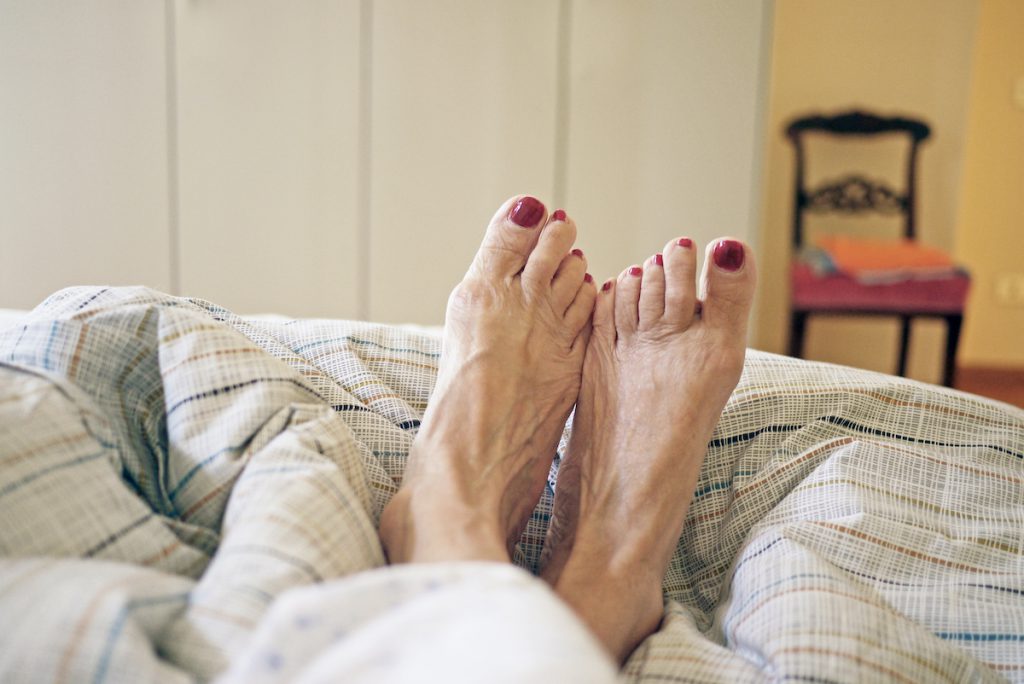9 Solutions for Tired, Achy Feet
You don’t have to grin and hobble through foot pain. Use these strategies to find relief.

Happy feet, happy life. OK, that’s not the adage — but it certainly rings true for anyone who’s ever had to walk through annoying foot pain.
About a quarter of all older adults experience some type of foot pain, according to a 2018 study published in the Journal of the American Podiatry Medical Association. “As we age, we may develop foot arthritis, the fat pads in our feet atrophy, and all our ligaments, muscles, and tendons weaken,” explains Hillary Brenner, D.P.M., a podiatrist in New York City.
But you don’t just have to grin and hobble through the pain. Here are nine ways to find relief.
Add SilverSneakers to your wellness routine! Classes and events are happening right now at participating gyms, online through SilverSneakers LIVE, and at community centers near you. Activate your free online account to get started.
1. Wear the Right Shoes
Shoes that are too tight or too pointed can lead to foot pain because it can aggravate conditions such as bunions, which are bony bumps that form on the joint at the base of your big toe, says Alex Kor, D.P.M., a spokesperson for the American Podiatric Medical Association and podiatrist in Lebanon, Indiana.
Look for shoes that have a large toe box. “A lot of patients will say to me, ‘I bought a wider shoe, and it didn’t help,’ but a wide shoe can still be narrow in the toe,” he explains.
In addition, he recommends that when shoe shopping, you actually try to bend it with one hand on the heel of the shoes, and the other hand on the shoe’s arch. “If it easily bends in half, it raises the chances that it can cause or worsen plantar fasciitis, an inflammation of the thick band of tissue that connects the heel bone to the toes,” he says.
Learn more about buying the right footwear by reading 5 Shoe Mistakes Many Older Adults Make here.
2. Don’t Pad Around Barefoot
“Going barefoot forces your feet to absorb all the shock from body weight and gravity pushing down and the ground pushing up,” says Jacqueline Sutera, D.P.M., a podiatrist in New York City.
In addition, as part of the normal aging process, the fat pad on the bottom of feet becomes thinner, she notes. This can cause chronic pain and callus formation under bones and pressure points. To minimize the discomfort and slow down the deterioration, she recommends that you wear supportive slippers whenever you walk around your house. If slippers aren’t your style but you don’t want to track dirt and debris in your home, you can choose a comfortable pair of shoes to be your indoor-only “house” shoes.
3. Stretch Often
“Stretching helps to loosen the connective soft tissue like tendons and ligaments that holds our bones and joints together, which reduces the chance of injury, inflammation and pain,” says Sutera.
Top of her list is a calf stretch, which lengthens and loosens both the Achilles tendon and the plantar fascia. Press play to try three different calf stretch variations:
Sutera also recommends these two stretches for your feet:
Forefoot stretch: Pull apart the front of the foot by grabbing onto the great toe joint and pinky toe joint.
Ball of foot stretch: Press the toe joints back toward the top of the foot, and then bend them forward toward the bottom of the foot.
Do these stretches at least once a day.
4. Soak Your Feet
A warm foot soak with Epsom salt can be very soothing for your feet at the end of the day, especially if you have arthritis, says Brenner. She recommends that you do this two-to three times a week, for twenty minutes.
Finish up with a quick foot rub to help increase blood flow to the area. Follow this up by donning moisturizing foot booties that are lined with gel infused oils like grapeseed or avocado. “It’s like doing a home moisturizing facial for your feet,” says Brenner.
5. Do Foot Exercises Daily
Foot exercises can help with arthritis related pain, by increasing blood flow to joints. They can also improve balance, which is decreased in older adults, notes Sutera.
She recommends three simple exercises:
Toe grips: While seated, place marbles or other small objects on the floor in front of you and try to pick them up with your toes.
Single-leg balance: Stand near a wall, counter, or sturdy piece of furniture and balance on one leg.
Air-draw the letters of the alphabet: While seated or standing (use support, if needed), use your big toe as the pointer. Move only your ankle, keeping the rest of your leg still.
Subscribe to our newsletter
It's quick and easy. You could be one of the 13 million people who are eligible.
Already a member? Click to discover our 15,000+ participating locations.
Follow Us
“These exercises are intentional and focus on small muscles,” she says.
6. Keep Your Feet Toasty Warm
Some people are prone to conditions that are related to temperature. Raynaud’s syndrome is a condition where the blood vessels go into a temporary spasm, which decreases blood flow and causes the skin of your fingers and toes to change to white, according to the Mayo Clinic. It’s usually triggered by cold temperatures but can be experienced year-round. (Stress is another trigger for Raynaud’s.)
Another condition related to cold temps is chilblains. This is a painful inflammation of small blood vessels in your feet that occurs in response to repeated exposure (or re-exposure) to cold. It can cause itching, red patches, swelling and blistering.
Since both conditions can happen even indoors, Sutera recommends wearing thicker socks, doubling up on socks, or wearing both socks and slippers to warm up your feet.
7. Don’t Be Afraid to Ice
If you have an inflamed, painful bunion, or plantar fasciitis, use an ice pack or wrap for about 20 minutes two or three times a day for relief. Another trick to ease plantar fasciitis pain is to roll your foot over a frozen water bottle for 15 to 20 minutes to stretch out the area and reduce inflammation, says Brenner.
8. Check Your Feet Daily if You Have Diabetes
More than a quarter of all adults over the age of 65 have type two diabetes, according to the Centers for Disease Control and Prevention. If you’re one of them, it’s very important that you check your feet every day for cuts, redness, swelling, sores, blisters, corns, calluses, or any other change to the skin or nails. (You can use a mirror if you can’t see the bottom of your feet.)
This daily check can help prevent diabetic wounds and ulcers, which can be life-threatening, says Sutera. It’s also important to trim your toenails regularly and smooth any sharp edges with a nail file, to prevent cuts to your feet.
9. Consider an Orthotic
If you’ve tried some — or al l— of the above tips, and still notice foot pain, you may want to consider an over the counter orthotic, recommends Brenner. These can often take pressure off of your feet by adding more support, especially if you’re flat footed. Brenner recommends PowerStep orthotics. But if pain persists, see a podiatrist, who can fit you with a custom option.
Activate Your FREE SilverSneakers Online Account
Get hundreds of free SilverSneakers On-Demand videos and stay in touch with us by creating your free online account. You don’t have to be a SilverSneakers member to get on-demand workout videos, health and fitness tips from SilverSneakers, and more.
SilverSneakers members can go to thousands of nationwide gyms and fitness locations, plus take SilverSneakers LIVE online classes led by specially trained instructors and designed for all fitness levels and abilities – at no additional cost. If you have a Medicare Advantage plan, it may include SilverSneakers. Check your eligibility here.
Already a member? Get your SilverSneakers member ID, search for locations near you, and all the health and wellness resources you need by logging in to your online member account here.





